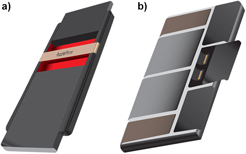Crossref Citations
This article has been cited by the following publications. This list is generated based on data provided by
Crossref.
BENHAMOU, Latifa
Giard, Vincent
and
Fénies, Pierre
2021.
Un outil de conception et de production intelligent permettant la personnalisation d’une production continue de masse.
Revue Française de Gestion Industrielle,
Vol. 36,
Issue. 1,
p.
07.
Machado, Natália
and
Morioka, Sandra Naomi
2021.
Contributions of modularity to the circular economy: A systematic review of literature.
Journal of Building Engineering,
Vol. 44,
Issue. ,
p.
103322.
Santato, Clara
and
Alarco, Pierre‐Jean
2022.
The Global Challenge of Electronics: Managing the Present and Preparing the Future.
Advanced Materials Technologies,
Vol. 7,
Issue. 2,
Shi, Lin
Mach, Katharine J.
Suh, Sangwon
and
Brandt, Adam
2022.
Functionality‐based life cycle assessment framework: An information and communication technologies (ICT) product case study.
Journal of Industrial Ecology,
Vol. 26,
Issue. 3,
p.
782.
Schischke, Karsten
Proske, Marina
Pamminger, Rainer
Glaser, Sebastian
Nissen, Nils F.
and
Schneider-Ramelow, Martin
2022.
Towards a Sustainable Future - Life Cycle Management.
p.
15.
Boorsma, Nina
Polat, Esra
Bakker, Conny
Peck, David
and
Balkenende, Ruud
2022.
Development of the Circular Product Readiness Method in Circular Design.
Sustainability,
Vol. 14,
Issue. 15,
p.
9288.
Amend, Clara
Revellio, Ferdinand
Tenner, Isabell
and
Schaltegger, Stefan
2022.
The potential of modular product design on repair behavior and user experience – Evidence from the smartphone industry.
Journal of Cleaner Production,
Vol. 367,
Issue. ,
p.
132770.
Vasalou, Asimina
and
Gauthier, Andrea
2023.
The role of CCI in supporting children’s engagement with environmental sustainability at a time of climate crisis.
International Journal of Child-Computer Interaction,
Vol. 38,
Issue. ,
p.
100605.
de Waal, Ida Mae
2023.
The Legal Transition towards a More Circular Electrical and Electronic Equipment Chain—A Case Study of The Netherlands.
Sustainability,
Vol. 15,
Issue. 2,
p.
935.
Shevchenko, Tetiana
Cluzel, François
Yannou, Bernard
Shams Esfandabadi, Zahra
Ranjbari, Meisam
Saidani, Michael
and
Danko, Yuriy
2024.
Completing the design for product circularity toolkit with hierarchical computation of circularity maturity diagram and redesign circular strategies.
Journal of Cleaner Production,
Vol. 437,
Issue. ,
p.
140742.
Schaltegger, Stefan
Amend, Clara
and
Wüst, Sebastian
2024.
From rebound to reinforcement effects—The role of analyzing underlying mechanisms for accounting.
Journal of Sustainable Finance and Accounting,
Vol. 3,
Issue. ,
p.
100014.
André, Francisco J.
Arguedas, Carmen
and
Rousseau, Sandra
2024.
Strategic pricing, lifespan choices and environmental implications of peer-to-peer sharing.
Journal of Environmental Economics and Management,
Vol. 125,
Issue. ,
p.
102953.
Seliger, Norbert
and
Leirich, Nico
2024.
Reconfigurable Board-to-Board Interconnect Utilizing Bistable Compliant Ribbon Wires.
p.
1.
Marzolla, Rafael Amoroso
and
Zancul, Eduardo
2024.
Upgradable Products for Circularity: a Bibliometric Analysis.
Procedia CIRP,
Vol. 128,
Issue. ,
p.
615.
Jerome, Adeline
and
Ljunggren, Maria
2025.
Product lifetime in life cycle assessments of circular economy strategies — A review and consolidation of methodology.
The International Journal of Life Cycle Assessment,
Harris, Steve
Romare, Mia
and
Zhang, Yuqing
2025.
Comparative life cycle assessment of circular and linear product versions for a motorboat and smartphone.
Sustainable Production and Consumption,
Schomberg, Anna C.
Mostert, Clemens
and
Bringezu, Stefan
2025.
Best Practice for Right to Repair and Supply Chain Regulations: High-reparability Modular Smartphone Usage Model Mitigates Environmental Hotspots.
Highlights of Sustainability,
Vol. 4,
Issue. 1,
p.
38.
Yang, Chaoxiang
Yuan, Bingkun
Yan, Chao
Huang, Zhengyang
Zhang, Yimin
and
Wan, Yongjing
2025.
A product form generative green design method based on consumer aesthetic preference.
Research in Engineering Design,
Vol. 36,
Issue. 2,
